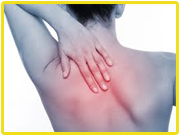
A non-invasive gentle approach. This technique was developed by an osteopath Dr. John Upledger, to balance the flow of the cerebrospinal fluid that circulates in a loop from the skull to the sacrum.
This craniosacral system uses the meningeal system (the membranes of the brain and spinal cord) that constantly bathes the spinal cord and brain. The CSF is continuosly pumped in a rhythmic fashion with contraction and expansion. Restrictions to the flow can result in a number of neuromuscular disorders and create chronic pain.
The practitioner first seeks to locate restrictions in the cerebralspinal fluid flow, which most often occurs in the skull and pelvis. Treatment consists of gentle pressure on bones and soft tissue from the head to the base of the spine to improve circulation of the cerebralspinal fluid.
Sessions last up to one hour.
Craniosacral therapy has been effective for treating head traumas, headaches, sinus congestion, TMJ syndrome, behavorial problems and neurological impairments. It also is used to treat infants who suffer from respiratory and digestive disorders (colic), and congenital, and genetic problems.

A hands-on therapy that deals with the movement and energy of the internal organs. This technique was developed by Jean Barral.
"Meeting the movement inside" is a poetic and accurate description of this technique. It is the practitioner's training and sensitivity through which the art of "meeting the movement inside" is achieved.
It is through neurological findings and the associated spinal segments that the mobility of the inner organs are assessed. The treatment emphasis is placed on the diaphragm --a large muscle used for breathing-- which causes the movement of many organs against each other.
Many dysfunctions of organs and structures can manifest as hypomobility or hypermobility -- that is, they move too much or too little.
Treatment is systematic and specific using connective tissue structures, such as ligaments and membranes of the inner organs.
This approach is effective for dysfunctions in the thoracic, abdominal, and pelvic cavities.